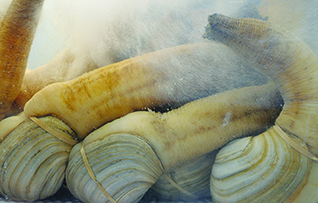 th trade ban on U.S. West Coast shellfish ended this week, and a leading geoduck producer expects shipments of the large and lucrative clam species to resume by early June.
th trade ban on U.S. West Coast shellfish ended this week, and a leading geoduck producer expects shipments of the large and lucrative clam species to resume by early June.There was some question as recently as Wednesday morning among U.S. shellfish suppliers whether the ban was being lifted only for geoducks, but it is indeed for all bivalve shellfish. However, a specific and detailed testing regimen has not yet been established for entry into China. The National Oceanic and Atmospheric Administration (NOAA) is expected to conduct a conference call on the matter on Thursday and will begin issuing health certificates to exporters immediately.
China has become a big market for U.S. geoducks, which exported nearly USD 72 million (EUR 53 million) worth of live/fresh product in 2013, mostly from Washington state. That market has been closed since 3 December 2013, when Chinese officials reported finding unacceptable levels of paralytic shellfish poisoning and inorganic arsenic in shipments from Alaska and Washington, respectively.
Bill Dewey, spokesman for Taylor Shellfish Farms in Shelton, Wash., says his company lost about USD 1 million (EUR 735,648) to USD 1.5 million (EUR 1.1 million) each month in sales as a result. Taylor, which also ships oysters to China, ended up laying off about 30 employees, though increased spring farming activities has allowed some to be rehired.
Taylor was able to diversify its sales as the ban wore on, expanding sales domestically and in other Asian markets. Sales increased to Vietnam, and Dewey acknowledged that some of the product that left the United States for Vietnam may have ended up in China illegally.
“It’s hard to control once it leaves SeaTac and is into the hands of middlemen,” said Dewey. “We spent a lot of time ensuring who we were selling to was not moving it on to China. We did not want to create a political situation with the government.”
After a face-to-face meeting with Chinese officials in March, Dewey says NOAA officials came back convinced that the ban was a public health issue and not a political one. “They were as anxious to get it resolved as we were,” said Dewey.
The lesson that Dewey hopes is learned here is a geographical one: In their investigation, Chinese officials referred only to export health certificates, which said the geoducks were harvested from “Area 67,” as that is all that form requires or allows. But as Dewey explained, Area 67 stretches from northern California to Siberia. If China agrees to refer to already-provided shellfish harvest tags, it would allow for pinpointing any tainted samples to specific areas of concern. Harvesting or exporting could therefore be limited to affected areas instead of the entire West Coast.
China’s limit for inorganic arsenic is 0.55 parts per million. Dewey said that recent tests on farmed geoduck show that the animals are clearly safe to consume.
“We’ve done enough testing at this point on our farmed animals to feel confident we don’t have an issue,” he said.





